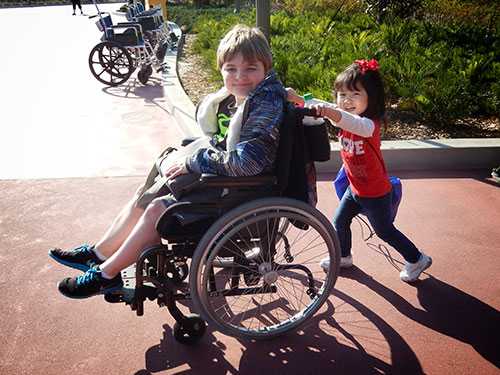Research and Tracking

MD STARnet
The Centers for Disease Control and Prevention (CDC) funds the Muscular Dystrophy Surveillance, Tracking, and Research Network, known as MD STARnet. MD STARnet collects critical information about muscular dystrophy that will improve care for those living with the disease.
MD STARnet is the only research program designed to collect health information on everyone with muscular dystrophy living in specific areas of the United States. Most muscular dystrophy research programs collect health information only on people with the disease who are treated by specialists at certain medical clinics. In contrast, MD STARnet collects this information from medical clinics, as well as other sources, including hospitals, and birth and death certificates.
By collecting health information on a large number of people from multiple sources, MD STARnet research can be used to help improve the care and quality of life for those living with muscular dystrophy. The more we know about the experiences of people with muscular dystrophy, the more we can learn about the course of the disease, and what leads to a better quality of life.
In 2014, CDC awarded funding for the next 5-year phase of MD STARnet research. Funding was awarded to the organizations below. The states or regions where health information data on muscular dystrophy will be collected are in parentheses.
- University of Iowa (Iowa)
- Colorado Department of Health and Environment (Colorado)
- New York State Department of Health (21 counties in Western New York)
- Research Triangle Institute (31 counties in North Carolina’s Piedmont region)
- South Carolina Department of Public Health & Environmental Control (South Carolina)
- University of Utah (Utah and Nevada)
What We Have Learned
MD STARnet research on Duchenne and Becker muscular dystrophy (DBMD) has found that
- An estimated 1 in every 7,250 males aged 5 – 24 years had a diagnosis of Duchenne or Becker muscular dystrophy. 1
- Duchenne muscular dystrophy is three times more common than Becker muscular dystrophy. 1
- There is an average time of one year from when parents first noticed a sign or symptom of physical developmental delay in their child, to when they took their child to a pediatrician or family practitioner for evaluation. 2
- There is an average delay of two and a half years from when parents first noticed the earliest sign or symptom of physical developmental delay in their child to when their child received a definite diagnosis of Duchenne muscular dystrophy. 2
- Corticosteroids (steroids) are medicines that slow the muscle damage caused by DBMD. Treatment with steroids among boys with DBMD living within the MD STARnet sites ranged from more than half (57%) to more than two-thirds (69%). The average age when boys began taking steroids was 7 years. This study also found that the average age when heart problems began was 14 years, and that for every year steroids were taken, the chance of developing heart problems decreased by 4%. 3
- Another study showed that treatment with steroids has increased during the past 20 years, although Hispanics and non-Hispanic Black males with DBMD are treated with steroids less frequently and start them later in life compared to non-Hispanic White males. 4
- Nearly half (45%) of the oldest males affected with DBMD in each family had at least one of three mental health concerns: behavior concerns, depressed mood, or attention-deficit/hyperactivity disorder (ADHD). 5
- Males 1-29 years of age with DBMD who were treated with steroids were more than twice as likely to have behavioral concerns as those who did not receive steroid treatment. 5
- Males 1-29 years of age with DBMD who were losing their ability to walk were more likely to have behavioral concerns. They were also more than three times as likely to have a depressed mood as those who were still able to walk independently. 5
For more information on MD STARnet research see Data and Statistics.
MD STARnet Research Questions
MD STARnet recently expanded to include muscular dystrophies other than DBMD. These include myotonic, limb-girdle, facioscapulohumeral, congenital, distal, oculopharyngeal, and Emery-Dreifuss muscular dystrophies. For more information on these muscular dystrophies, visit our Facts page.
CDC and partners from state public health departments and universities hope to answer the following key questions:
- How many people are affected by these types of muscular dystrophy?
- Are certain muscular dystrophies more common among specific racial and ethnic groups?
- What health services are patients and their families receiving?
- As people with muscular dystrophy become adults, what healthcare services are they receiving, how much education did they receive, and what are their opportunities for employment?
- What are the healthcare costs for people with muscular dystrophy?
- What treatments help people with Duchenne muscular dystrophy live longer?
- For people with muscular dystrophies, do race, ethnicity, education, or where a person lives affect access to healthcare services?
Mental health and DBMD
Mental health concerns among males with Duchenne and Becker muscular dystrophy.
(Published: June 4, 2015)
DBMD prevalence by race/ethnicity
Proportion of Duchenne and Becker muscular dystrophy in the United States among certain races and ethnicities.
(Published: February 17, 2015)
Conor’s Story
Conor actively advocates for people with disabilities. Learn more about his story living with Duchenne muscular dystrophy.
(Published: August 31, 2017)
New Tool for Parents Helps Address Concerns
A tool to help parents concerned about their child’s physical development.
(Published: February 23, 2016)
Muscular Dystrophy: Kevin’s Story
Read about Kevin, a man with muscular dystrophy who doesn’t let the condition define him.
(Published: February 11, 2013)
References
- Romitti PA, Zhu Y, Puzhankara S, James KA, Nabukera SK, Zamba GK, Ciafaloni E, Cunniff C, Druschel CM, Mathews KD, Matthews DJ, Meaney FJ, Andrews JG, Conway KM, Fox DJ, Street N, Adams MM, Bolen J; MD STARnet. Prevalence of Duchenne and Becker muscular dystrophies in the United States. Pediatrics 2015 Mar;135(3):513-21.
- Ciafaloni E, Fox DJ, Pandya S, Westfield CP, Puzhankara S, Romitti PA, Mathews KD, Miller TM, Matthews DJ, Miller LA, Cunniff C, Druschel CM, Moxley RT. Delayed diagnosis in Duchenne muscular dystrophy: data from the Muscular Dystrophy Surveillance, Tracking, and Research Network (MD STARnet). J Pediatr 2009 Sept;155(3):380-5.
- Barber BJ, Andrews JG, Lu Z, West NA, Meaney FJ, Price ET, Gray A, Sheehan DW, Pandya S, Yang M, Cunniff C. Oral corticosteroids and onset of cardiomyopathy in Duchenne muscular dystrophy. J Pediatr 2013 Oct;163(4):1080-4.e1
- Fox DJ, Kumar A, West NA, DiRienzo AG, James KA, Oleszek J; MD STARnet. Trends with corticosteroid use in males with Duchenne muscular dystrophy born 1982-2001. J Child Neurol 2015 Jan;30(1):21-6.
- Caspers Conway K, Mathews KD, Paramsothy P, Oleszek J, Trout C, Zhang Y, Romitti PA; MD STARnet. Neurobehavioral concerns among males with dystrophinopathy using population-based surveillance data from the Muscular Dystrophy Surveillance, Tracking, and Research Network. J Dev Behav Pediatr 2015 Jul-Aug;36(6):455-63.
- Page last reviewed: January 13, 2017
- Page last updated: July 19, 2016
- Content source:



 ShareCompartir
ShareCompartir